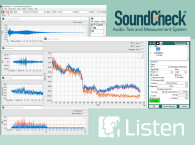
Test configuration data, such as limits, test levels, and test signals, can now be passed into SoundCheck from external programs using TCP/IP commands. By externally storing parameters, a single sequence can be used for multiple products, simplifying the number of sequences that a large organization needs to maintain, and reducing test configuration time. This functionality is also useful for applications where a sequence needs to be run many times with different parameters, for example, testing voice recognition with a range of voices or test levels, or where SoundCheck tests are run as part of a larger automated test framework controlled using Python, C#, Visual Basic, LabVIEW, etc.
Setup time is reduced with true plug’n’play hardware configuration. Listen and Portland Tool & Die interfaces are simply connected via the USB cable, and the software automatically creates input and output signal paths and populates parameters such as sampling rate and calibration values. Furthermore, when substituting devices of the same type, SoundCheck will re-use the configuration previously set up, either manually or during a sequence, so that signal paths and sequence configurations do not need to be updated. This offers significant time-savings when deploying a sequence over multiple stations accelerating set-up time for large-scale operations.
Listen also introduces IEEE 1451 Transducer Electronic Data Sheet (TEDS) support for manufacturer-related information. TEDS support (with compatible Listen hardware) enables automatic identification, configuration and calibration of TEDS microphones and accelerometers, also saving time on initial hardware setup or whenever hardware is changed.
The development and optimization of test sequences has also been simplified with improvements to gain control selection. Similarly, sampling rate management has been streamlined with automatic latency rate adjustment for devices where latency varies with sampling rate, and the ability to set sampling rate in the stimulus editor. Sampling rate when using WAV files is also now automatically adjusted, making it simpler to make measurement with wave file signals such as speech or music.

For MEMS microphone tests, the Portland Tool & Die MEMS interfaces can now be controlled from within SoundCheck for faster setup as well as greater measurement reliability as the device settings can be built into the test sequence. Sequences using the R&D grade DCC-1448 interface will also work seamlessly with the production-grade PQC-1448, making it much simpler to transition sequences from the R&D lab to the production line.
Additional new features include WASAPI driver support for improved multichannel capabilities, and enhanced digital I/O control for easy conversion of sequences between hardware options.
SoundCheck, Listen’s audio test and measurement software is suitable for measuring any type of audio device from a basic driver to complex voice-activated devices such as smartphones, smart speakers, hearables and automotive infotainment systems, and is used worldwide by the world’s leading consumer electronics companies.
www.listeninc.com






